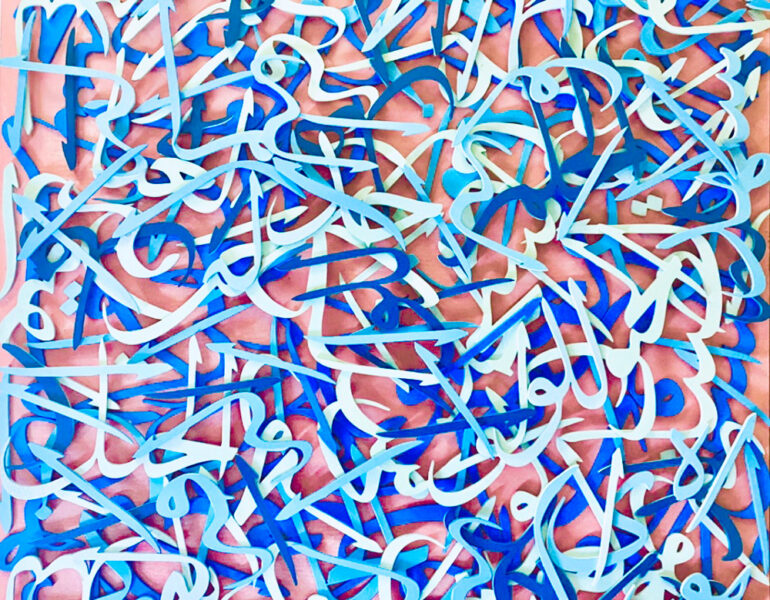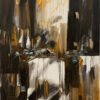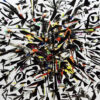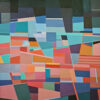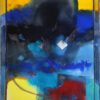Mental & Spiritual Enlightenment
Introduction
A painting in fine art is usually interpreted in the sense that it is a “full” occupying the “void”. So, it is more like a white space to be furnished with colors, shapes, lines, volumes, shadows, and lights. Be that as it may, what if what the painter does is no more than creating space within the painting, in the sense that he’s creating the possibility of the unanticipated or the “not yet”? What if it is, in the art of painting specifically, about liberating the painting – every time – from our prejudgments – that a painting is a simulation of reality, idea, or nature; or that it is a representation of the Self that is designed under specific aesthetical and preferential standards? Fine arts are rarely interpreted from the angle of the space, and this is the objective of this research. For that, we will try to resort to an amusing intuitive that will constitute a formulating thread for this research that we found in a book called “What is Philosophy?” in which we read that a painting “is only a work of art, as the Chinese painter says, it nonetheless saves enough empty space for horses to prance in”[1]. Building on that text, we can trace the history of the space back to the Chinese Imagination, in particular, where the space “the emptiness”, in the Orient in general and in the Taoist philosophy in particular, resembled the original state of objects. Chang Tsai, the Chinese philosopher, tells us about the “supreme emptiness” or the Nothing, as being “What was before heaven and earth…”[2] which is manifested through smoke, vogue, and clouds”[3]. This emptiness becomes an artistic concept also, as the Chinese Philosopher also states: “Within every painting moved by true void, a soul freely roaming”[4] . It is, in fact, a philosophical and aesthetical battle between two perceptions of emptiness: a western perception who “fears void” so it keeps on invading the world’s whiteness with knowledge, technologies, representations, metaphors, and interpretations to possess it; with an oriental perception on the other side who favors emptiness, prone to meditation, and emptying the world of all the interpretational noise around. This philosophical battle about the aesthetical notion of space is the problematic hypothesis that this research is trying to address.
What is space? What’s the difference between void, nothing, nothingness, formlessness, and non-existence…? Why does the West fear space while the East is delighted to create it and contemplate it? What difference does the density of lines and the halo of space make in constituting an artistic spirituality for the world?
The history of Emptiness (Space):
Emptiness has always represented a controversial topic in philosophy and in science, back from the days of Pythagoras, Democritus, Zeno of Elea, and Aristotle, to the days of Descartes, Pascal, Kant, and from Empedocles and Epicurus to Newton and Einstein and Quantum Physics. In fact, we can say that philosophers and scientists themselves are divided in the way they perceive the world into two categories: Emptiness advocates; those who believe that the world is plenty of atoms and vacuum, and Fullness advocates; those who refuse to acknowledge emptiness in nature, because nature, since the days of Aristotle fears emptiness. The question here would be: what risks would it carry to acknowledge emptiness or deny it in the way we perceive the world; in our beliefs, knowledge, and the way we imagine and represent the images of objects in our mind?
Emptiness – which we call in old Arabic “خلاء void” – versus full, is in its origin a physical concept, and it indicates the absence of matter. In astrology, emptiness refers to the space in which celestial objects align. In quantum physics, we might speak of the False vacuum or the unstable state of the vacuum. The concept of space was replaced with the “Aether” concept in the General Relativity…
Void is originally attributed to Leucippe, the pre-Socratic Greek philosopher (460 – 370 BC) who believed the matter is only two things: the imperishable, indivisible elements which are atoms, and void, which is the space that atoms do occupy, and can move and grow in it. Later on, Democritus, Leucippe’s student (Around 440 BC), who formulated the atomic theory, carried on with the void idea, and defended the idea saying that the world is infinite, and it has heavy, solid, and indivisible particles. This was the theory on which Epicurus would later build his philosophy. In the year 400 BC, almost a century before the emergence of the void concept, Zeno of Elea have come up with his paradoxes in which he made arguments against motion theory. Based on that theory, the void concept was disproved by Empedocles who believed that the world is filled with particles and void does not exist. From there another theory sparkled, that the space is not empty, it rather swims in “Aether” which is a pure essence, and it was added by Aristotle to what the philosophers called The Four Elements (fire, air, water, earth). The concept of the void was rehabilitated by Epicurus, and then Lucretius after him, when they argued that any movement of atoms would require a void. In modern ages, this dialectic around void would continue from Galilei until Einstein’s time. While Galilei (1564 – 1642) has taken interest in the concept of the void as an experimental space in which standard ideal scientific conditions for gravity, Newton, who founded Classical Mechanics, defended the idea of “Aether” against the void. He considered that space is filled with Aether, which is an essence that does not carry any physical properties, and it makes the movement of objects possible. An idea with which Einstein stood, as he considers that physical objects do not exist “in space”, but rather have a “spacetime manifold”, thus refuting the idea of a void, so it became meaningless… however, Quantum Physics – the last station we arrive at in the scientific history of the notion of emptiness – acknowledges vacuum as the lowest state of energy, and according to the Uncertainty principle, we cannot determine the exact value of this energy. Still, we can refer to the quantum fluctuation of vacuum, i.e. the small excursions of an electromagnetic field in which particles and antiparticles collide corresponding to the “Vacuum energy”.
In the difference between void, nothingness, non-existence, and the nothing:
Fethi Meskini, the Tunisian philosopher, in an article published on a website[5], works on finding the difference between void, nothingness, and non-existence. Based on an amusing thesis stating that the void is an idea specific to the Chinese and Buddhist culture, and that the non-existence is a Greek Paganism idea, and nothingness is the “metaphysical ultimate contribution of Abrahamists”. The Orient believes that the void is the origin of all things, Greeks had the perception that the origin of things is “Chaos”, while Abrahamic religions believe that “God created the world from nothing”. However, the most problematic concept of all here, according to Meskini, is “emptying the world of any specific existence”[6]. The solution to that would be what Zen culture suggests, which is the “exercise of searching for the void and utilizing it properly to establish serenity”[7]. Meskini here is keen to emphasize the idea of contradiction between West and East on the notion of emptiness. So while the West “fears emptiness”, the East is keen on “Generating internal emptiness, as emptiness alone could free a space to meet the other, a person was it or a world”[8]
As for the “Nothing” idea, Emanuel Kant, the Philosopher of modernism and enlightenment, dedicated the end of the first part of his Analysis “Critique of Pure Reason” to a table of division of it. Nothing, according to Kant is “a concept without object”. He finds in negation his main expression, and he sorts a table of Nothing, devising its significations into four concepts; first “Nothing as an empty concept without object”, second as “Empty object of a concept, and third as “Empty intuition without an object”, and fourth as “Empty object without concept”…[9]. It is worth mentioning here that this state of introversion in which the modern west mind analyzes the truth about The Nothing only reflects what we initially interpreted; that the West is confused about the emptiness concept. What’s intended here is that the emptiness can only exist in relation to a “fullness” of the mind, i.e. the cognitive theory that sees anything beyond its epistemological system as a Nothing, i.e. the Impossible. The impossible is any image that is abstracted from any sensible perception, and anything that is absolutely inconceivable, and it’s, to use Kant’s words any “Imaginary Being”[10].
Emptiness and Imagination:
We can only think of emptiness starting from its projection within the imagination. Imagination concept here is what matters, in the sense that the philosophical foundation of the “free roaming of imagination” in the modern aesthetics field, as drawn in Kant’s book “Critique of Judgment”, is what’s going to open the door in modern philosophy on different possibilities for the concept of emptiness to work on several fronts. As long as the imagination is the space in which emptiness is produced, which the self cannot possibly know. Imagination would later become the artistic field that would be gaining a higher position, since Friedrich Nietzsche, the German Philosopher announced that we need to make “art the highest task and the essential metaphysical capability of this life”[11] and man to an “artistic trace”[12]. This aesthetical project is manifested through several philosophical approaches to art. Of those we mention Merleau-Ponty’s philosophy and the “Visible and Invisible”[13] dialectic, Jacques Derrida and Aesthetics of Absence[14], and Deleuze in the dual of “The smooth and The Striated”[15], from which Buci- Glucksmann, the French philosopher, has introduced what she called the aesthetics of “lightness”[16] driven by the “White Square” of Kazimir Malevich[17], the Russian artist who founded abstract art, which was regarded as an expression of the “zero state of form”[18] and the “dizzying space”[19]. This aesthetical curve, which was based on the space in fine art to liberate the visual horizon from the noise of the narrations and interpretations, was initially introduced by Jean-François Lyotard, the French Philosopher, who formulated its aesthetical theory and included exceptional interpretational features of reading into visual arts, starting in his book “Discourse, Figure”[20], and specifically in his book “What to Paint”[21] that has these unusual methods and content.
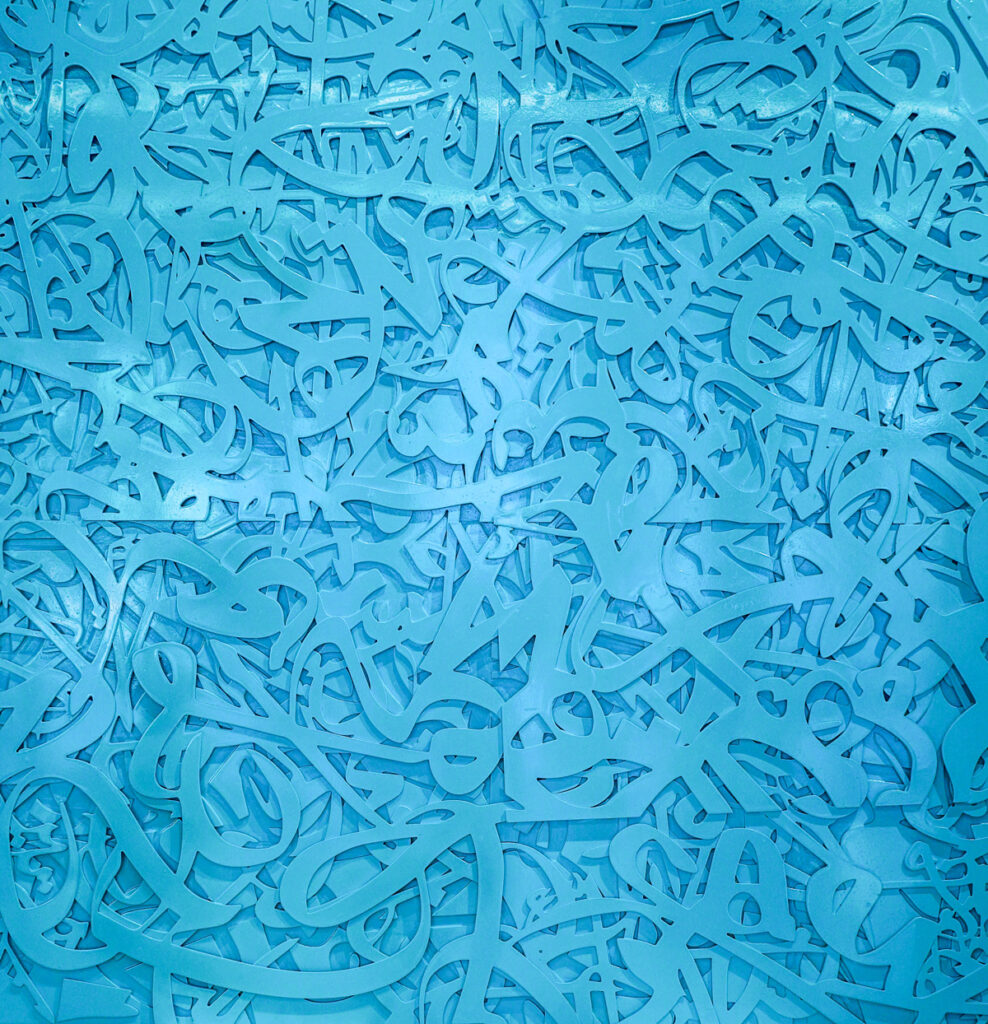
What to Paint in Fine Art Paintings? Space or Fullness?
What to Paint? Is an amusing title for a complex and problematic philosophical question, which has fascinated post-modern fine arts. It is not exactly a title, because it eliminates the element of certainty in titles when they walk with confidence to an area of meaning. However, writing now is highly required, under the crisis of metanarratives, to turn into a magnetic field in which questions grow. “What to Paint?” is a question-title that concludes the authority of the talking-self in speech. Selfless paintings, yet standing in front of us, in majestic silence: what pattern of existence do fine arts suggest today? Is it still possible to depict the world in an image after the end of the metanarratives? Do fine arts still have a form to claim and to provide us with as if the world still has its early innocence?
Jean-François Lyotard, the contemporary French philosopher who introduced the concept of postmodernism into philosophy[22], suggests a pattern of visual discourse based on dialogues, intermittences, points of space, and other forms invented by nebula and capturing the energy of silence and absence. In which, the word gets distributed in an amusing theatrical way over “you” “he” “she” “East” “West”… in the way that pronunciation conditions get redistributed within the philosophical discourse. It also has dictations of exceptional architectures that makes of “presence”, “line”, “exemption”, “loss of memory”, “point”, “location”, and “display” new titles and concepts for the problematic topics of fine arts, and on an aesthetical stage, Lyotard takes the artworks of Valerio Adami, the Italian contemporary artist, Daniel Buren, the French contemporary artist, and Arakawa[23], the Japanese fine artists, as modulates through which we can experience a different interpretation of visual arts, that advocates space against the established perception that we need to dominate the whiteness of canvas with colors, shapes, volumes, and shades, as if the painting was a story.
How to paint? What to paint? Is the sensible presence what’s being painted or is it the idea? Every stroke of color hide world behind it, it hides the waits; the social, the psychological, and the cultural waits. That necessarily generates a state of skepticism whenever we stand in front of a painting. From what Maurice Merleau-Ponty called “Cezanne’s Doubt”[24], up until the artworks of Arakawa, the Japanese artist, and his painting “There Is No Space but the Viewer..”[25]
It is about testing this main thesis: there is a battle between East and West regarding the problematic concept of space, not only in nature, as in what happened from Pythagoras to Einstein, but also in arts. The battle mainly starts with the contradiction between Adami and Buren in the west, and Arakawa’s artwork in the East. Lyotard criticizes the history of western art, while laying a philosophical eye on the east, seeing it as the varied destination that can-do justice to people who are different, and provides them with a new area of fairness and recognition. Such matter is a part of the Philosophers of Difference plan since Foucault, Derrida, and Deleuze… and we consider Lyotards’s book “What to Paint?” one of the key moments in the postmodernist criticism, which diagnose the crisis of Western art, and provides East with a channel to suggest its artistic point of view to the world.
“I believe that the western history of painting can only tell us so little about the sensible presence”[26], says Lyotard, which means that the idea in Western art has always prevailed sensible presence, that is because “every representation is one form of story forms, which are, in turn, discourses in memory”[27]. Therefore, western painting art had long been dominated by intellect, in the absence of presence. “The art of presence gets absent” even, narration wins over painting, and nostalgia becomes requisite for representation. The question that Lyotard finds no easy answer for is then: “if the things we see are a few, and the things we think about are many” why do we paint? And then he finds an answer to it in Arakawa’s artworks, where we can find a new Cogito of fine arts where “there is not much for us to see, and nothing to understand”[28]
Building on that new Cogito of fine arts, Lyotard holds a philosophical debate between the narrative paradigm that advocates for the memory and the visual model, and recaptures the sensible presence as a mere artistic event, against Adami’s drawings, which open its windows to the memory and perfect the narrative plot within a painting; Arakawa introduces the painting as if it is no more than an event that is happening. What matters in such a painting is not what it has to say, but its mere occurrence, so it becomes both the place and time. Lyotard here invites a debate between narration advocates, i.e. Western painters, who still believe that they can always say more, and they can dominate the world with their discourse about the idea, the concept, the being, and the universality… against contemplating advocates, i.e. Eastern painters, who undermine this whole interpretational visual system, which denies presence and embrace the memory. The Eastern paintings find in blank space the aesthetical room to liberate the self from any claim to dominate the world. In this context, he compares Adami and Arakawa, as he considers Adami to be the plot, the interwoven lines, where a thousand story emerges from the will of a touch, in the way memories dominate the materials, setting up the narrative stage, as if there was an audience, and it was kicked away.[29] Against Adami, the representational luxury”[30], there appears Arakawa, the Japanese artist, who “tricks plots”[31] and undermines them. Within the context of this comparison between two paradigms of fine art specifically, the concept of space emerges as the concept that dictates our interpretation of fine arts.
When we embrace the western paradigm of aestheticism, we find ourselves within an interpretation of visual arts that sees them as a representation of reality, an idea, a story, or a narrative of memory. But when it comes to shifting paradigms, we need no more than looking at the painting as if it was what’s happening here and now, by accident, without the need for a preceding cause or a self to justify its aesthetical values.
The Artistic Dialogue between the Point and the Line:
The difference between the western and the eastern representation of the world is mainly manifested in the difference between the line and the point. That is to say, the blank space that we see in Arakawa’s, the Japanese artist, artworks for his usage of the point instead of the line. This is a dispute between two representational architectures of the world: The lines of Adami, and the points of blank scattered in Arakawa’s artwork. In his book “What to Paint”, Lyotard dedicates a whole chapter to “The Point”. In this chapter, he sets a philosophical stage between the “East” and the “West”, in the way he structuralizes his titles. It is as if enabling the blank space in fine art is the road leading to enabling the dialogue between the east and the west again. Nonetheless, this dialogue would not be the traditional one. It will not be between the West, who’s superior in science to the East. A new dialogue, where fine arts are the foundation, and the artistic blank space is the incentive for the East to regain dominance in fine art. This dialogue is between the narrative of the full, which is based on filling the space with lines; and the reflections of the “Zen” which allows the blank points, i.e. the free spirits, to liberate the souls of the noise of chatters and spiritualize the space… it is indeed true, as we need to invent space, so we can set ourselves free from the crowdedness in the world and its fast pace, where our souls are stressed in its hands, and the piles of merchandize are invading everywhere.
What does space impose on us? What energy does it have when it comes to remapping the world? Lyotard provides us with these answers at the beginning of his chapter about the dialogue between “East and West” about the “Point”: if what you want is to understand Arakawa, then Arakawa does not require to be understood”[32]. The understanding model is foreign to the aesthetical values of the orient, those based on contemplation. What the Japanese artist really requires is a “blank space”[33], that is “space-time, an inhabited desert of an empty-full…”[34] this blank emerges from the oriental “Zen” culture, and Arakawa invites us, following the Buddha’s teaching, to “sit on the mountain and eat rice”[35]
What does the Eastern artist teach us about space?
It provides us the world again with a handful of meanings that can be summarized into three points:
1) Space does not accept specification, or understanding. It just invites us to see and contemplate.
2) There is no cognition without the points of space.
3) Space is where the energy can self-generate[36]
4) Space emancipates us from embracing “fullness”, in which our bodies and soles get robbed. It also provides us with the ability to regain serenity.
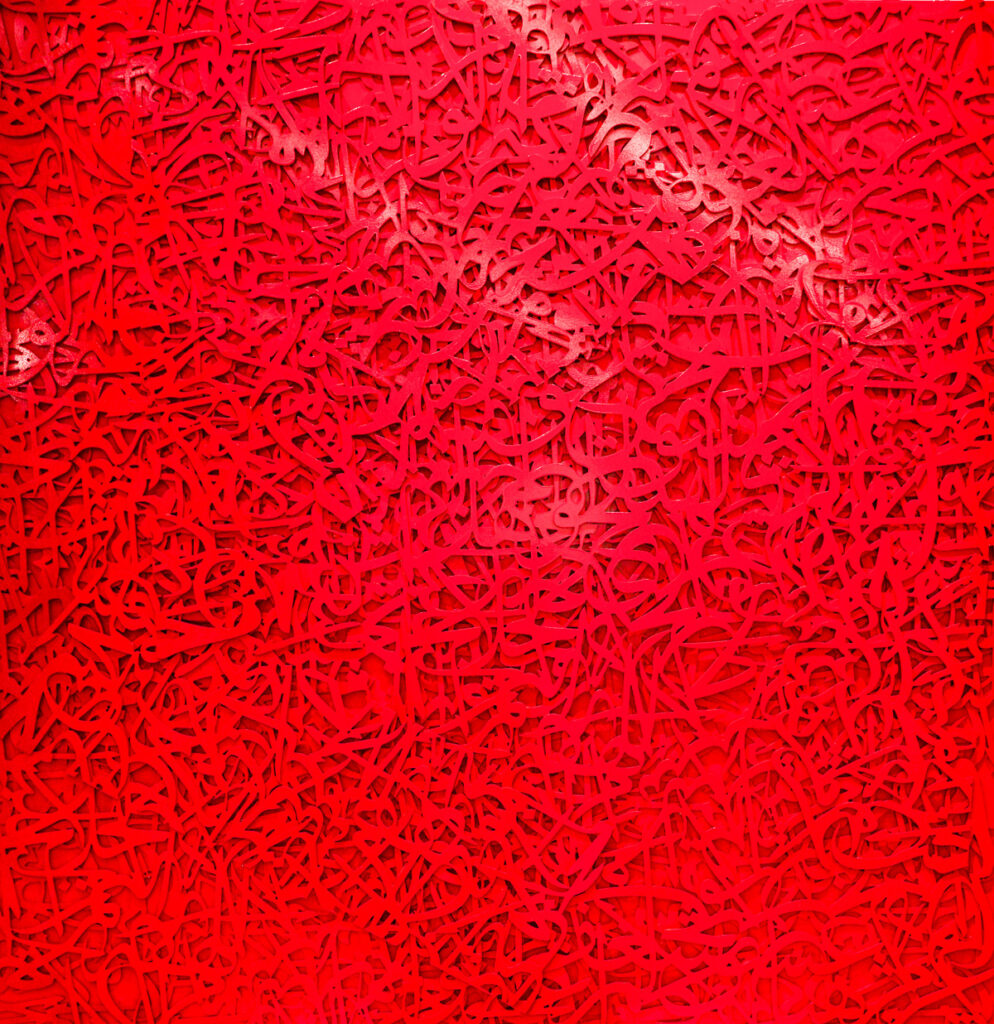
Conclusion: The most important points that we gain from this philosophical approach to space concept in fine arts are the following conclusions: First: The concept of space paves the way for new interpretations of fine arts. It also adds varying aesthetical dimensions and new preferential values, so much that they can find in the silence of the painting, in the moments of whiteness, and in the zero state of shape and color, whole new possibilities to re-shape the world in new configurations. Second: Approaching fine arts from the angle of space concept can liberate the artistic horizon from the alleged meanings that were accumulated by the West aesthetics on top of an aesthetic selfness that’s confident of the success of its world and its ability to possess the maps of being and the patterns of residing in it. The interpretation of space aims to open the doors for the pleasure of contemplating, which is especially manifested in abstract art. Third: Space has an aestheticism that opens our eyes to the areas of contemplating what’s happening in the light of what happened only. This aestheticism, while drawing the borders of Western aesthetical values, provides us, as we carry the idea of the East deep down, a unique artistic position on the visual geometric maps of the world, which is incarnated in calligraphy. Fourth: The aestheticism of space in fine art doesn’t always require us to have a memory, which makes nostalgia a requisite for representation. The scene before our eyes is a celebration of the zero-state of visual, we’re in the time, we’re even the time and the place. Therefore, creating art is our way of celebrating what’s happening with no illusions, no allegations, and no noise, we’re in the presence of an artistic perception that’s inviting us to void the world of all kinds of metaphysical noise surrounding it.
[1] Deleuze, G., & Guattari, F. (1994). What is philosophy?. New York: Columbia University Press.
[2] Francois Cheng , Vide et plein , le language pictural des chinois , Paris , Seuil, 1979, 27
[3] Ibid
[4] Ibid
[5] Fethi Meskini, Abrahamists and Nothingness, the invisible history of Vicegerency, Mominoun without Borders, june 3, 2018 (In Arabic)
[6] Ibid
[7] Ibid
[8] Ibid
[9] Kant, Immanuel, Paul Guyer, and Allen W Wood. Critique of Pure Reason. Cambridge ; New York: Cambridge University Press, 1998, page 383
[10] Ibid
[11] F. Nietzsche , Naissance de la tragédie, Paris , Gallimard , 1949 , p.20
[12] Ibid, page 26
[13] Maurice Merleau – Ponty, Le visible et l’invisible , Gallimard , 1988
[14] Jacques Derrida , La vérité en peinture, Paris , Flammarion , 1978
[15] G. Deleuze, F. Guattari , Mille Plateaux, Paris , Minuit , 1980
[16] Christine Buci- Glucksmann, L’œil cartographique de l’art, Paris , Galilée , p.145
[17] Kasimir Malevitch
[18] Christine Buci – Glucksmann, L’œil cartographique de l’art, op.cit , p. 146
[19] Ibid
[20] J.F, Lyotard , Discours ,Figure, Paris , Kliencksieck , 1971
[21] Jean- Francois Lyotard , Que Peindre , Hermann Editeurs, 2008
[22] Lyotard. J.F , La condition postmoderne , Paris , Minuit , 1979
[23] Shusaku Arakawa (1936-2010)
[24] Maurice Merleau – Ponty , Sens et non Sens , Paris , Nagel , 1948
[25] Arakawa, there is no space but the Vieuwer, 1986
[26] Jean-Francois Lyotard, Que Peindre ?, Adami, Arakawa, Buren, Paris, Hermann, 2008, pp.11-12
[27] Ibid,pp.12-13
[28] Ibid, p.14
[29] Ibid, p.60
[30] Ibid
[31] Ibid, p. 58
[32] Ibid, p.109
[33] Blank, Ibid, p.109
[34] Ibid
[35] Ibid, p.60
[36] Ibid, p.141
A researcher in philosophy, and a critique of aesthetics. professor in the Philosophy department at The Higher Institute of Human Sciences of Tunis, with a specialization in: Western modern philosophy and modern aesthetics.

